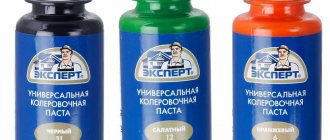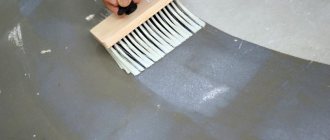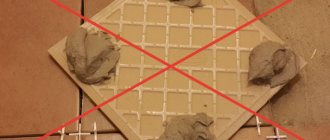It is difficult to predict when you will need glue at home: there are force majeure situations when something needs to be glued together or a crack needs to be repaired urgently, but you still need to get to the store, and the shopping center’s opening hours have already ended. Sometimes you need to glue something small, if you buy a whole package of glue for this purpose, there will be another “half a jar” on the shelf, which will stand there until it deteriorates.
Therefore, homemade glue made from polystyrene foam and gasoline has become popular in everyday life. His recipe is simple, and there is always a use for it.
Where can it be used?
The scope of application of glue from scrap materials is huge. In the domestic sphere, it is used to repair roofs, facades, furniture, if necessary, correct interior decoration, glue a loose piece of tile, seal holes that have appeared in the wrong place, and seal surfaces.
For what materials is it used:
- paper, cardboard;
- wood, particle boards (chipboard, fibreboard, MDF);
- ceramics;
- slate;
- metal;
- concrete.
Since all compositions, of which there are many, are based precisely on mixing polystyrene foam and some kind of solvent, this glue is not suitable for every plastic. Food grade and regular household plastic can lose their strength and become deformed. But when working with plastic suitable for flammable liquids, such problems do not arise. For example, if a leak occurs in a plastic canister, it can be repaired with a patch of thick household glue, and for several more years the container will work properly without letting in a drop of water at the sealing site.
It is worth considering that glue does not adhere well to smooth surfaces, and this applies not only to plastic. It is capable of gluing parts with a glossy surface, but first you need to thoroughly matte the joint on both parts and wipe with acetone immediately before the gluing procedure. Glue is applied to both sides.
The mixture perfectly replaces polyurethane foam: suitable for sealing cracks in roofs, walls, stairs, wooden objects (window frames, window sills, doors, door frames, lining). Large cracks are filled with a spatula; small cracks are filled with a pastry syringe, instead of which you can use a thick bag with a corner cut off. For external repairs, the uncured glue is sprinkled with sand or covered with a clean rag.
Many people do not recommend using glue with this composition for decorative repairs: due to its consistency, it is quite difficult to apply accurately. But if the front surface of the object near the joint is lubricated with oil, no traces of glue will remain. The main thing is not to drip grease onto the place where the glue will be applied.
Useful: the strength and durability of the connection will depend not only on the material being glued, but also on the quality of the components included in the glue itself.
After complete hardening, the substance becomes glassy and holds quite tightly, but you should not use it to attach objects that are under constant or heavy load.
It is possible to use a mixture of gasoline and polystyrene foam as a varnish. To do this, the mixture is made almost liquid, jelly-like. Essentially, it turns out to be liquid plastic. Applied in a thin layer, when hardened it turns into a film and serves as an excellent protection against moisture. Used for waterproofing:
- wooden, metal, concrete fences;
- concrete walls and floors; roofing;
- household items made of wood.
There is a misconception about using homemade adhesive to adhere insulation. As a rule, to preserve heat, sheets of polystyrene foam are used, which in composition is the same foam, only made using a different technology. And the solvent-based glue simply “eats away” the bulk of this material, leaving only a layer of air as insulation.
Results
Foam glue can be used for exterior finishing of house facades. For example, for waterproofing the base, fastening roofing felt, blocking the opening of a sewer pipe in the country. Also, the glue works well in contact with tiles and asbestos-cement slate. If there are cracks, they are treated with an adhesive composition on both sides, and a fabric-based patch is applied on top. This patch can last at least 1.5 years.
What is needed for cooking?
Homemade tips are oversaturated with variations of components suitable for preparing inexpensive homemade acetone glue. Some of what is written on the Internet is fiction (for example, the fact that glue is “free”. Inexpensive - yes, for gasoline or solvent stored in the garage, you still once had to pay at least a small amount of money, but they use unnecessary foam for it, from leftovers, they don’t buy it on purpose), something that is really suitable for use.
Which foam to choose
The base of the glue, as is clear from the topic of the article, is foamed plastic or polystyrene. Most of it is gas, which will be released during the dissolution process, so you will need a lot of foam.
Useful: at home, almost everyone has pieces or scraps of polystyrene after insulation, or packaging foam or crumbs from it after purchasing household appliances. This is what is usually used to prepare the adhesive.
Types of foam suitable for making glue:
- Bespressova. This type of foam is used as a shockproof layer when packaging equipment. The leaf easily crumbles into many small balls of which it is composed.
- Press. It is the same as pressless foam: a large number of balls. Only during manufacturing is the foam mass pressed, which increases the density of the material.
- Extrusion. During its production, high temperature is used, so it has a solid, homogeneous structure.
How to dissolve polystyrene foam to make glue?
The solvent element is directly a solvent suitable for foam, or gasoline.
Liquid components use different:
- acetone;
- petrol;
- solvent 646 or 647, xylene.
Method 4. Stationery tape
If you urgently need to repair a crack in your windshield, use simple tape. It is recommended to always carry this tape with you in your car. You need to seal the crack on both sides and it will be stopped. However, this will not last long, because after one cold night the tape will come off due to condensation.
Saving your windshield with tape is far from a solution to all your troubles. The tape will be able to protect the car interior from dirt and dust, and will also be able to stop the crack. However, you shouldn't expect more from tape. You will need to take this problem more seriously and contact an auto service. Before this, you need to drive extremely carefully, try to avoid sudden braking and driving at high speed, otherwise the crack will destroy the windshield.
Share:
Features of the composition
For preparing glue, a non-pressed type of foam or ready-made crumbs from it are best suited. This option melts faster than others, crumbles easily and, dissolved in gasoline, turns into a homogeneous viscous mass.
Before mixing, the foam is cleaned of dirt and dust. You also need to make sure that it does not contain impurities, including varnish and paint.
Useful: under no circumstances should foam plastic, suitable for insulating underground communications, be used, since it is impregnated with a fire-fighting compound that releases toxic fumes when dissolved.
The most commonly used is AI-95 gasoline. It is easier to obtain than solvent, and even if the family does not have a car, a small amount is often stored at home for household needs. To liquefy the foam, you need fuel without additives. In gasoline, the foam turns into a rather dense lump, more similar in consistency to taffy, and the excess liquid is drained off. It is difficult to apply such a substance in a thin layer, but with strong compression with a press or clamps, excess glue is driven out and removed. To prepare glue based on it, foam plastic does not need to be crushed; even large pieces dissolve quite quickly.
Solvent 646 allows you to create a more uniform and less thick mass. Although if the glue turns out to be too liquid, it will not be able to perform its main function - to hold it together. When choosing a 646 glue solvent, you need to pay attention to its composition. Made according to GOST - with a high acetone content - it will work perfectly, but on the market there are 646 from some manufacturers that do not dissolve foam at all.
Solvent 647 is very similar to 646 in its effect on foam, but it dissolves faster and the mass is more homogeneous.
If you need to prepare a completely liquid mixture (for a waterproofing coating), it is recommended to take xylene. With this solvent, the adhesive mixture can reach the consistency of liquid sour cream, ideal for application with a brush or roller over a large coverage area. With this composition, the base crumbles as finely as possible, but undissolved pieces of foam may still remain in the xylene. They simply need to be thrown aside when applying the substance to the surface to be coated.
Acetone is the leader among components in the speed of dissolution of foamed plastic into homogeneous glue. But it also has one drawback: acetone molecules evaporate too quickly, which is why gluing must be done quickly, before the mixture dries.
Useful: nefras (“Galosh”) does not dissolve foam, so it is impossible to prepare glue with it.
The transparency of the mixture after hardening will depend on the components, primarily on the foam. It is impossible to know in advance whether the glue will be transparent or cloudy, or whether it will be white or gray. If it matters, you can make a small amount of glue from exactly what will be used for the main mass and check what it becomes after drying.
Steps for pouring a marble floor
The actions of mixing components and applying coating are carried out by experienced craftsmen without instructions. It's a matter of experience. But the proposed filling option does not suffer from errors.
The first step is to prepare the concrete space. It must be freed from foreign objects and thoroughly swept away from dust. There is no need to additionally moisten with water or treat the surface. Next comes the preparation of the component composition:
1. Take a plastic container that is resistant to acetone. A 5 liter bottle is ideal.
2. Cut off the neck of the bottle for more convenient pouring of reagents.
3. Fill the container with two liters of acetone.
4. Dissolve the foam in the amount necessary to form a cloudy slurry.
5. Add a liter of xylene.
6. Add color.
7. Apply the resulting thick liquid to the surface of the concrete.
8. After 2 hours, re-coat the floor.
It is important to carry out work in a ventilated area, regardless of the time of year. For convenience, it is better to open the garage door
Because the substances emit harmful fumes. You can apply three layers. No one forbids experimenting with colors. The cost depends on the size of the garage and the design preferences of the owner. Although the average amount of 500 rubles is unlikely to become unprofitable. But it will save time on cleaning the room.
Test of strength
After some time, we run our fingernail over the foam paint. The paint is very durable and there are no visible cuts.
If you run your fingernail over regular paint or spray paint, the nail mark remains.
Where to apply this paint is up to you. We just conducted an experiment and learned about the strength of foam paint.
Making glue from foam plastic
- It is better to do “cooking” indoors with good ventilation or outdoors. The vapors released during the dissolution process can be toxic, and if you inhale them frequently, you can get sick.
- The place should be away from sparks and fire. Polystyrene foam combined with gasoline burns for a long time, beautifully, but not at all safe.
- The container selected is glass or metal; only plastic that is suitable for storing fuel is used.
- You will need a “stirrer”: a stick, an unnecessary spoon, a piece of reinforcement - everything that you wouldn’t mind throwing away later if the glue hardens on this item.
Useful: during the process, personal protective equipment is used - rubber gloves.
Thick glue recipe
Gasoline is poured into a clean, dry container. Fill no more than 2/3 of the volume, since during the reaction it foams strongly, the level will increase. It is necessary to dissolve the lump foam, periodically stirring the lump in gasoline, until the required amount of finished glue is obtained.











